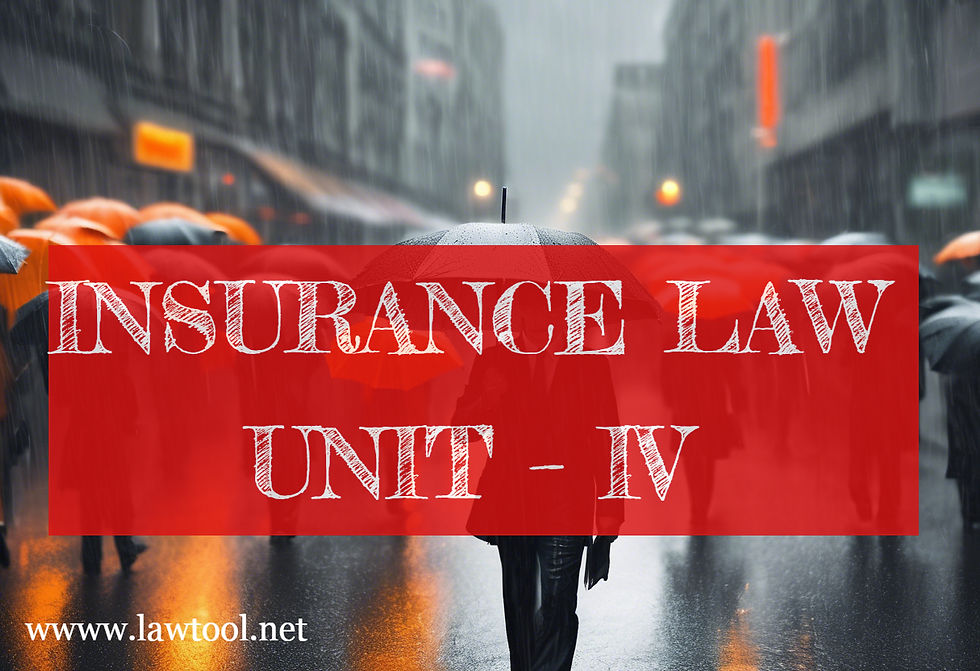INSURANCE LAW UNIT – IV
- www.lawtool.net

- 11 hours ago
- 7 min read
Fire insurance is an essential tool that protects individuals and businesses from the devastating effects of fire-related disasters. It is a critical part of the insurance industry, playing a vital role in risk management. This blog will explore the nature and scope of fire insurance, its basic principles, the rights and duties of the involved parties, and pertinent claims and legal aspects. Additionally, we will examine agricultural insurance in India, covering its history, underwriting, claims processes, and various issues related to crop and cattle insurance.
INSURANCE LAW UNIT – IV
Fire Insurance: • Nature and scope of Fire Insurance – • Basic Principles – Conditions & Warranties – Right & Duties of Parties – Claims Legal Aspects. • Introduction to Agriculture Insurance – History of Crop Insurance in India – Crop Insurance Underwriting, Claims, and problems associated with Crop Insurance – Cattle Insurance in India.
Nature and Scope of Fire Insurance
Nature and Scope of Fire Insurance
Definition: Fire insurance is a contract where the insurer agrees to compensate the insured for loss or damage caused by fire or related perils (e.g., lightning, explosion).
Scope:
Covers buildings, goods, and machinery.
Applies to both personal and commercial properties.
Can include extensions like riots, strikes, and natural calamities (if endorsed)
Fire insurance provides financial compensation to policyholders for losses incurred due to fire damage to their properties. It covers both movable and immovable assets, including buildings, machinery, inventory, and equipment.
The scope of fire insurance goes beyond covering just property damage. It can also include risks like damage from smoke, explosions, and water used in firefighting. For example, a manufacturing plant may suffer losses not only from the fire itself but also from damages linked to smoke or water used to extinguish the flames. Policies can be tailored to meet specific business or individual needs, enhancing protection against unforeseen disasters.
Whether for a small shop or a large factory, fire insurance is crucial for safeguarding investments. This necessity is especially evident in industries prone to fire hazards, such as agriculture, manufacturing, and hospitality. In fact, industries like manufacturing can experience losses of up to 50% during a significant fire incident, making insurance even more vital.
Basic Principles of Fire Insurance
To effectively navigate fire insurance, one must grasp its basic principles:
Basic Principles
Insurable Interest – The insured must have a legal or financial interest in the property.
Utmost Good Faith – Full disclosure of all relevant facts is mandatory.
Indemnity – The insured is compensated to the extent of loss only, not profit.
Subrogation – Insurer gets the right to sue the third party responsible for the loss.
Contribution – If multiple insurers exist, all contribute proportionally to a claim.
Proximate Cause – The dominant cause of loss must be fire or an insured peril.
Insurable Interest
For a fire insurance policy to be valid, the policyholder must have a stake in the insured property. If a property is damaged or destroyed by fire, the policyholder should face a financial loss. For instance, an owner of a retail store insured against fire losses must have a financial investment in the inventory and building.
Utmost Good Faith
Also called "uberrima fides," this principle requires both the insurer and the insured to disclose all relevant information. The insured should accurately represent all risks associated with the property, while the insurer should clearly communicate the terms and conditions of the policy. An example would be a factory owner disclosing the presence of highly flammable materials, which could affect the policy terms.
Principle of Indemnity
This principle aims to restore the policyholder to their financial state before the loss occurred. It prevents the insured from profiting from their insurance, focusing instead on compensating for actual losses. For example, if a business suffers $100,000 in damages from a fire, they should only be compensated for that amount, not more.
Subrogation
After settling a claim, the insurer can claim reimbursement from third parties responsible for the loss. For instance, if a faulty electrical system caused a fire, the insurer may seek damages from the manufacturer once they compensate the policyholder.
Contribution
When a property is insured under multiple policies, this principle ensures that the insured can claim only once for the loss. The payouts will be distributed among insurers based on the extent of coverage. For example, if a policyholder has two policies covering $50,000 each, they can only claim up to the actual loss amount.
Conditions and Warranties
Conditions & Warranties
Conditions: Part of the policy contract (e.g., timely premium payment, claim procedures).
Warranties: Promises made by the insured (e.g., maintenance of fire extinguishers). Breach can void the contract.
Fire insurance policies come with specific conditions and warranties that policyholders must adhere to:
Conditions
Premium Payment: Timely premium payment is crucial for keeping coverage valid. Missing payments can lead to lapses in coverage.
Duty of Disclosure: Policyholders must inform the insurer of any changes to the property or risk exposure to maintain their insurance.
Loss Notification: Quickly reporting incidents is necessary to initiate the claims process effectively.
Warranties
Warranties are specific conditions that must be met for the policy to remain valid. Examples include:
Maintenance of Fire Safety Equipment: Keeping fire extinguishers and alarms functional and up to date.
Compliance with Fire Safety Regulations: Following local regulations can significantly impact coverage and claims processing.
No Material Alteration: Major changes to the property that increase fire hazards must be disclosed to the insurer.
Rights and Duties of Parties
Rights & Duties of Parties
Insured’s Duties:
Disclose all material facts.
Pay premium on time.
Take reasonable care to prevent fire.
Notify the insurer promptly after a fire.
Insurer’s Rights:
Survey and investigate the damage.
Repudiate claims in case of fraud or policy breach.
Subrogate against third-party wrongdoers.
Understanding the rights and duties of all parties involved in fire insurance is key for effective policy management.
Rights of the Insured
Claim for Indemnity: The insured has the right to claim for losses covered under the policy.
Information Access: The insured can request details about their policy's terms and any changes affecting coverage.
Overinsurance Compensation: If overinsured, the insured may only claim to the extent of their actual loss.
Duties of the Insured
Disclosure: Accurate information about the property and risks must be provided by the insured.
Cooperation: The insured must assist the insurer during investigations and claims processes.
Post-loss Duties: After an incident, the insured must take steps to prevent further losses, such as securing the property.
Rights of the Insurer
Claim Investigation: The insurer can investigate claims to confirm their validity.
Premium Adjustment: Insurers can adjust premiums based on changes in risk.
Subrogation Rights: After settling a claim, the insurer can seek reimbursement from the responsible party.
Duties of the Insurer
Policy Clarity: Insurers must provide clear terms and conditions, ensuring understanding for the insured.
Timely Claims Settlement: Insurers are obligated to settle claims promptly once validated.
Fair Treatment: Insurers must treat all claims fairly, without discrimination.
Claims and Legal Aspects
Claims - Legal Aspects
Claim Process:
Intimation of loss.
Surveyor appointment.
Submission of claim documents.
Settlement.
Legal Considerations:
Claim must be within the scope of the policy.
Fraudulent claims lead to denial and possible legal action.
Disputes are settled under the Indian Contract Act, Insurance Act, and by Insurance Regulatory and Development Authority of India (IRDAI).
Navigating the claims process is crucial for benefiting from fire insurance.
Claims Process
Incident Notification: As soon as a fire incident occurs, notify the insurer.
Documentation: Gather evidence like photographs and witness statements, along with loss estimates.
Claim Submission: Complete the insurer’s claim form and submit all necessary documentation.
Investigation: The insurer will assess damages and validate the claim.
Claim Settlement: Based on the investigation, the insurer will settle the claim as per policy terms.
Legal Aspects
Legal considerations significantly impact fire insurance, including:
Policy Interpretation: Courts tend to interpret ambiguous policy terms in favor of the insured.
Breach of Contract: Not adhering to policy terms can lead to claim denial or legal disputes.
Consumer Protection Laws: Regulations ensure fair treatment of policyholders and require compliance with ethical practices.
Insights into Agricultural Insurance
AGRICULTURE INSURANCE
Introduction to Agriculture Insurance
Protects farmers against losses due to natural calamities, pests, and diseases.
Covers crops, livestock, and farming assets.
History of Crop Insurance in India
Initial Scheme: Introduced in 1972 on a pilot basis.
Comprehensive Crop Insurance Scheme (CCIS): Launched in 1985.
National Agricultural Insurance Scheme (NAIS): Started in 1999.
Pradhan Mantri Fasal Bima Yojana (PMFBY): Launched in 2016 to replace NAIS, offering improved coverage and lower premiums.
Crop Insurance Underwriting, Claims, and Problems
Underwriting: Based on area approach, historical yield data, and weather patterns.
Claims:
Based on actual yield vs threshold yield.
Loss assessment done by government-authorized bodies.
Problems:
Delay in claim settlement.
Low farmer awareness and participation.
Inadequate infrastructure and poor data.
Lack of private sector involvement in some areas.
Cattle Insurance in India
Covers livestock (cows, buffaloes, goats, etc.) against:
Death due to disease, accident, fire, and calamities.
Implemented under schemes like:
Livestock Insurance Scheme.
National Livestock Mission.
Challenges:
Difficulty in identification and tagging.
Fraudulent claims.
Poor veterinary infrastructure in rural areas.
Agricultural insurance protects farmers from risks associated with farming, including losses from bad weather, pests, and diseases.
History of Crop Insurance in India
Crop insurance in India has evolved since the 1970s, with the government introducing various schemes to support farmers. The Crop Insurance Scheme began in 1972, leading to initiatives like the National Agricultural Insurance Scheme (NAIS) in 2000 and the Pradhan Mantri Fasal Bima Yojana (PMFBY) in 2016. PMFBY aimed to streamline claims and broaden coverage, significantly aiding farmers' financial stability.
Crop Insurance Underwriting, Claims, and Problems Associated
The underwriting process assesses risks linked to specific crops. Insurers evaluate:
Geographical location: Different areas face varying agricultural risks.
Historical yield data: Past performance helps predict future outcomes.
Weather patterns: Understanding regional climate impacts is crucial.
Despite advancements, challenges remain, including:
Underreporting of Losses: Farmers may underreport losses to lower premiums, hurting claims accuracy.
Delayed Payments: Slow claims processing can leave farmers vulnerable during critical times.
Complex Application Procedures: Farmers often face difficulties navigating application processes, leading to confusion.
Cattle Insurance in India
Cattle insurance protects against livestock-related losses, crucial for dairy farmers.
Coverage Options: Policies usually cover death or permanent disability due to various risks.
Underwriting and Claims: Underwriting evaluates factors like age, breed, and health of the animal. However, bureaucratic red tape can delay claims.
Challenges: Major challenges include low awareness among farmers, limited insurance product penetration, and resistance to paying premiums.
Final Thoughts
Fire insurance is crucial for protecting a variety of stakeholders, from businesses to homeowners. Understanding its nature, principles, rights, and duties helps in making informed coverage decisions.
Agricultural insurance also plays a vital role in securing farmers' livelihoods through crop and cattle coverage. While important, several challenges need addressing to ensure farmers can fully benefit from these services.
In navigating the complexities of fire and agricultural insurance, having a comprehensive understanding of available options is essential. This knowledge can significantly mitigate risks and protect against substantial financial loss.
Staying informed about both fire and agricultural insurance is vital in an evolving landscape, as both sectors contribute significantly to economic stability and growth, helping stakeholders navigate risks effectively.










Comments